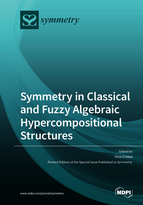Symmetry in Classical and Fuzzy Algebraic Hypercompositional Structures
A special issue of Symmetry (ISSN 2073-8994). This special issue belongs to the section "Mathematics".
Deadline for manuscript submissions: closed (31 January 2020) | Viewed by 27947
Special Issue Editor
Interests: theory of algebraic hypercompositional structures
Special Issues, Collections and Topics in MDPI journals
Special Issue Information
Dear Colleagues,
Symmetry plays a fundamental role in our daily lives and in the study of the structure of different objects in physics, chemistry, biology, mathematics, architecture, arts, sociology, linguistics, etc. For example, the structure of molecules is well explained by their symmetry properties, described by symmetry elements and symmetry operations. A symmetry operation is a change, a transformation after which certain objects remain invariant, such as rotations, reflections, inversions, or permutation operations. Until now, the most efficient way to better describe symmetry, is using mathematical tools offered by group theory.
Naturally generalizing the concept of a group, by considering the result of the “interaction” between two elements of a non-empty set to be a set of elements (and not only one element, as for groups), Frederic Marty, in 1934, only 23 years old, defined the concept of a hypergroup. The law characterizing such a structure is called multi-valued operation, or hyperoperation, or hypercomposition and the theory of the algebraic structures endowed with at least one multi-valued operation is known as the Hyperstructure Theory or Hypercompositional Algebra. Marty’s motivation to introduce hypergroups is that the quotient of a group modulo any subgroup (not necessarily normal) is a hypergroup.
The main aim of this Special Issue is to underline various aspects in Hypercompositional Algebra, the crisp and fuzzy one, where symmetry plays a crucial role. They are related (but not limited) to equivalence relations, orderings, permutations, symmetrical groups, graphs, lattices, fuzzy sets, representations, etc. Applications of algebraic hypercompositional structures in physics, chemistry, biology, social sciences, information technologies, computer science, etc, where symmetry, or the lack of symmetry, is clearly specified and laid out, are also welcome.
Prof. Dr. Irina Cristea
Guest Editor
Manuscript Submission Information
Manuscripts should be submitted online at www.mdpi.com by registering and logging in to this website. Once you are registered, click here to go to the submission form. Manuscripts can be submitted until the deadline. All submissions that pass pre-check are peer-reviewed. Accepted papers will be published continuously in the journal (as soon as accepted) and will be listed together on the special issue website. Research articles, review articles as well as short communications are invited. For planned papers, a title and short abstract (about 100 words) can be sent to the Editorial Office for announcement on this website.
Submitted manuscripts should not have been published previously, nor be under consideration for publication elsewhere (except conference proceedings papers). All manuscripts are thoroughly refereed through a single-blind peer-review process. A guide for authors and other relevant information for submission of manuscripts is available on the Instructions for Authors page. Symmetry is an international peer-reviewed open access monthly journal published by MDPI.
Please visit the Instructions for Authors page before submitting a manuscript. The Article Processing Charge (APC) for publication in this open access journal is 2400 CHF (Swiss Francs). Submitted papers should be well formatted and use good English. Authors may use MDPI's English editing service prior to publication or during author revisions.
Keywords
- (Fuzzy) hypercomposition
- Symmetrical hypercomposition
- Ordered hyperstructures
- Symmetric group
- Symmetry
- Equivalence relation
- Representation of hyperstructures
- Graphs






